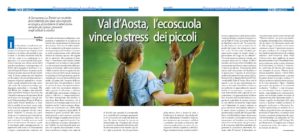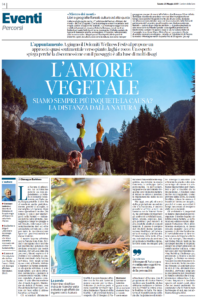- Email: g.barbiero@univda.it
- Prendere un appuntamento mediante posta elettronica.
Barbiero Giuseppe

- Ricercatore Universitario in Ecologia (BIOS-05/A)
Docente di Biologia e di Ecopsicologia e direttore del GREEN LEAF, il Laboratorio di Ecologia Affettiva del Groupe de Recherche en Education à l’Environnement et à la Nature dell’Università della Valle d’Aosta. È co-direttore della rivista scientifica internazionale Visions for Sustainability. I suoi principali interessi scientifici riguardano: l’ipotesi di Gaia (Gaia hypothesis), l’ipotesi della biofilia (Biophilia Hypothesis), la progettazione biofila (Biophilic Design) e la consapevolezza ecologica (Green Mindfulness). ![]() English webpage
English webpage
La mia pagina Google Scholar è qui
È autore di:
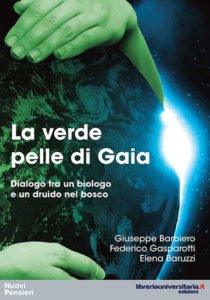 |
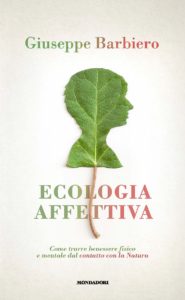 |
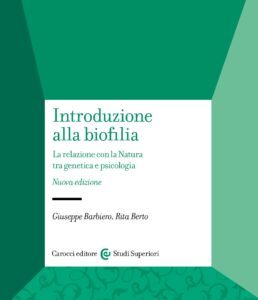 |
ECOLOGIA AFFETTIVA
spiegata in un vidoclip
Intervista di Elena Colombo di Atmosphera Lab (2024):
SCUOLE BIOFILE
La scuola biofila di Gressoney-La-Trinité (la prima scuola biofila in Italia)
La scuola biofila di Jovençan
CERTIFICAZIONI EDILIZIE
ARTICOLI SELEZIONATI
BARBIERO, G. (2024). Biophilic design reframed. The theoretical basis for experimental research. Ri-Vista. Research for Landscape Architecture, 21(2), 80–91. https://doi.org/10.36253/rv-15678
STOCCO, A., TABACCHI, C., BARBIERO, G., PRANOVI, F. (2023) The influence of naturalness of the landscape structure on children’s connectedness to Nature in North-eastern Italy. One Ecosystem 8: e111973. https://doi.org/10.3897/oneeco.8.e111973
BARBIERO, G., BERTO, R., SENES, G., FUMAGALLI, N. (2023) Wilderness is the Prototype of Nature Regardless of the Individual’s Connection to Nature. An Empirical Verification of the Solastalgia Effect. International Journal of Environmental Research and Public Health 20(14): 6354. https://doi.org/10.3390/ijerph20146354
BOLTEN, B., BARBIERO, G. (2023). Biophilic Design: Nine Ways to Enhance Physical and Psychological Health and Wellbeing in Our Built Environments. In: Capolongo, S., Botta, M., Rebecchi, A. (eds) Therapeutic Landscape Design. SpringerBriefs in Applied Sciences and Technology. Springer, Cham. https://doi.org/10.1007/978-3-031-09439-2_2
BERTO, R., BARBIERO, G. (2022) Biophilia. In Oxford Bibliographies in Ecology. Ed. David Gibson. New York: Oxford University Press. https://doi.org/10.1093/OBO/9780199830060-0239
BARBIERO, G., BERTO, R., VENTURELLA, A., MACULAN, N. (2021). Bracing Biophilia: When biophilic design promotes pupil’s attentional performance, perceived restorativeness and affiliation with Nature. Environment, Development and Sustainability. https://doi.org/10.1007/s10668-021-01903-1
BARBIERO, G., BERTO, R. (2021). Biophilia as evolutionary adaptation: an onto-and phylogenetic framework for biophilic design. Frontiers in Psychology, 12: 700709. https://doi.org/10.3389/fpsyg.2021.700709
BERTO, R., BARBIERO, G., BARBIERO, P., SENES, G. (2018). Individual’s Connection to Nature Can Affect Perceived Restorativeness of Natural Environments. Some Observations about Biophilia. Behavioral Sciences, 8, 34. https://doi.org/10.3390/bs8030034
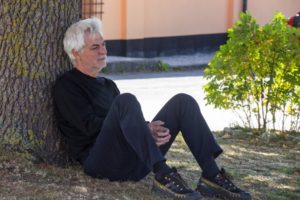 |
La mia pagina ORCID è qui |
Giuseppe Barbiero è ricercatore universitario nel Settore Scientifico Disciplinare BIOS-05/A Ecologia ed è direttore del Laboratorio di Ecologia Affettiva (GREEN LEAF) dell’Università della Valle d’Aosta. Insegna Ecopsicologia e Biologia nel Corso di Studi di Scienze e Tecniche Psicologiche.
Laureato in Scienze Biologiche all’Università di Torino, ha conseguito nel 1995 il titolo di Dottore di Ricerca in Patologia Sperimentale e Molecolare all’Università di Torino e ha collaborato fra il 1995 e il 1997 in qualità di borsista post-dottorato con il CNR di Genova e in qualità di collaboratore di ricerca fra il 2003 e il 2006 con il Dipartimento di Biologia Animale e dell’Uomo dell’Università di Torino, dove nel 2003 è stato tra i fondatori dell’Istituto di Ricerche Interdisciplinari sulla Sostenibilità (IRIS).
All’interno degli ambiti di ricerca generali del suo Settore, si occupa principalmente di Ecologia Affettiva e di Ecopsicologia. È autore di: Ecologia affettiva. Come trarre benessere fisico e mentale dal contatto con la Natura. Mondadori, Milano, 2017 e di Introduzione alla biofilia. La relazione con la Natura tra genetica e psicologia (con Rita Berto) Carocci, Roma, 2016.
È editor-in-chief (assieme a Martin Dodman) della rivista scientifica internazionale Visions for Sustainability. In qualità di membro del comitato scientifico partecipa al “Biosphera Project”, con capofila AktivHaus (general contractor) del Gruppo Nexlogic. In qualità di Responsabile di Unita di ricerca, partecipa al progetto “Green space for active living: older adults perspectives”, finanziato dalla Fondazione Cariplo con capofila l’Università Statale di Milano.
CURRICULUM ACCADEMICO
2013 Corso per formatori e divulgatori scientifici ‘Inquired Based Science Education’ (IBSE), presso il MuSE di Trento.
2000 Corso di perfezionamento in ‘Geofisiologia’, presso l’International School Earth and Planetary Sciences, Università di Siena, (15.09.2000).
1995 Dottorato di ricerca in Patologia sperimentale e molecolare Università di Torino (02.10.1995).
1993 Abilitazione alla professione di Biologo (20.04.1993).
1990 Laurea in Scienze Biologiche, Università di Torino (10.07.1990).
ESPERIENZE PROFESSIONALI
2014 – oggi Direttore della rivista scientifica internazionale Visions for Sustainability.
2006 – oggi Ricercatore di Ecologia (SSD BIO/07), Università della Valle d’Aosta (dal 02.05.2006)
2013 – 2016 Direttore dell’Istituto di Ricerche Interdisciplinari sulla Sostenibilità (IRIS), di cui è stato membro fondatore (2003)
2000 – 2006 Collaboratore di ricerca presso il Dipartimento di Biologia Animale dell’Università di Torino.
1998 – 2000 Coordinatore della sezione di Biologia, Grandi Opere UTET, Torino.
1995 – 1997 PostDoc CNR, progetto finalizzato “Invecchiamento”, Genova.
INCARICHI ACCADEMICI
2012 – oggi Responsabile del Laboratorio di Ecologia Affettiva (GREEN LEAF) dell’Università della Valle d’Aosta
2021 – 2024 Direttore del Groupe de Recherche en Education à l’Environnement et à la Nature dell’Università della Valle d’Aosta (GREEN-UniVDA)
2019 – 2021 Referente di Ateneo per la R.U.S. – Rete delle Università per lo sviluppo sostenibile
2012 – 2015 Membro eletto del Senato Accademico dell’Università della Valle d’Aosta, in rappresentanza del corpo docente.
PREMI E RICONOSCIMENTI
2017 Deposito in SIAE (n. 2017000273, del 24.01.2017) del Biophilic Quality Index (BQI), versione 1.0.
2008 Validazione del Formez dell’esperienza intersettoriale “Svelare la biofilia nei bambini” come buona pratica di prevenzione per Guadagnare Salute.
1995 Primo premio Comitato Gigi Ghirotti per lo studio e la terapia delle malattie del sangue.
-
Il Bosco di Puck
Bosco protetto – Terapie Forestali – C.S. Montecchio San Lorenzo 180A, Cortona (AR)
Centro di Osservazione Sperimentale del Laboratorio Ecologia Affettiva
Università della Valle d’Aosta – Université de la Vallée d’Aoste.
Il Bosco di Puck raccontato da Fiammetta Piras, M.D.
-
Allegati:
regolamento comitato tecnico scientifico in approvazione
5987-Other-18511-1-10-20210803
-
Sito ufficiale: http://biospheraproject.com/
10 ottobre 2018 – Agenzia DIRE https://www.dire.it/10-10-2018/252099-la-casa-addio-ai-4-muri-arriva-biosfera-dolce-biosfera/
German German German
-
GREEN AGE. GREEN SPACE FOR ACTIVE LIVING: OLDER ADULTS PERSPECTIVES
https://lastatalenews.unimi.it/fondazione-cariplo-14-progetti-statale-vincitori-bandi-dellarea-ricerca-2018
-
La prima scuola biofilica in Italia a Gressoney-La-Trinité. Sintesi del progetto e dei risultati di ricerca
2019 – TG3 ore 12 del 14 settembre 2019: La prima scuola biofilica in italia a Gressoney-La-Trinité.
Dal minuto 19:08 http://www.rai.it/dl/RaiTV/programmi/media/ContentItem-4e96cc78-63f9-4591-8bfc-406a3a9ac2bf-tg3.html#p=0
Tipologia: Ricerca internazionale
Link esterno: Nuova Architettura Sensibile Alpina – N.A.S.A.
- Casa editrice: Springer
- Coautori: Bettina Bolten
-
Abstract:
Biophilic Design is an applied science that takes into account the most recent findings on the relationship between human beings and Nature to render artificial spaces more coherent with innate human biophilia. It is well known that the application of Biophilic Design reduces stress, stimulates creativity and clear thinking, improves physical and psychological wellbeing and accelerates healing. Considering the relentless process of global urbanization, these benefits will become increasingly important in the design of our urban spaces, buildings and interiors. The aim of the present study is to develop a conceptual framework for Biophilic Design, reducing the gap between scientific research and its translation into functional applications.
- Anno di pubblicazione: 2023
- Tipo di pubblicazione: Chapter 2 in book "Therapeutic Landscape Design"
- Link esterno: https://link.springer.com/chapter/10.1007/978-3-031-09439-2_2
-
Allegati:
2023 - Springer Chapter-02_Bolten Barbiero ABSTRACT
-
Abstract:
Built environments that integrate representations of the natural world into façades and interiors benefit occupant psycho-physiological well-being and behavior. However, the biophilic quality of buildings does not de-pend exclusively on “green”, but also upon “organized complexity” in their structure. In this exploratory study we compare quantitative (Visual Atten-tion Software) and qualitative approaches (self-rating scales) in the perception of biophilic design of building façades. Eight façades varying in their degree of biophilic design (High, Medium, Low, No biophilic qualities) were assessed on the Perceived Restorativeness Scale-11, on preference, and on a series of physical aesthetic attributes. The eight façades were scanned with Visual At-tention Software (VAS). These measures show many overlapping points. VAS can be considered a way to operationalize the engagement of attention in the first 3-5 seconds of gaze in exploring building design, and self-ratings assess-ments a measure of to what extent the building is perceived as restorative. Higher perceived restorativeness and preference match a higher degree of bi-ophilic design, which corresponds to a building where vegetation is integrated in an organic structure. Vegetation is not the only biophilic characteristic to be considered in biophilic design and this emerges clearly from self-ratings and VAS. Exploring organized complexity is fundamental for understanding human responses to architecture.
- Anno di pubblicazione: 2023
- Link esterno: https://www.ojs.unito.it/index.php/visions/article/view/7054/6006
-
Allegati:
7054-Article Text-22480-3-10-20230610
- Anno di pubblicazione: 2023
-
Allegati:
2023 - Simbiosi 8 30-33 - La scimmia sapiens va alla guerra
- Coautori: Piras, P.F., Barbiero, G., Pinna, S., Fiordiponti, R., Lorenzoni, A., Carloni, C., Polito, V.A., Roomizi, R, Schirone, B.
-
Abstract:
La sempre più rapida diffusione e gravità di malattie infettive e di quelle cronico degenerative ha evidenziato la strettissima correlazione tra salute umana e alterazioni ambientali provocate dalle attività antropiche, mettendo contemporaneamente in crisi tutti i Sistemi Sanitari. Ciò ha riattualizzato il concetto di Sindemia, che considera come determinanti di salute le interazioni biologiche, ambientali, sociali ed economiche della popolazione e le politiche sanitarie che la coinvolgono, e quello di salute olistica di One Health. Tali approcci richiedono necessariamente prospettive interdisciplinari dove ciascuna disciplina si integra con le altre per affrontare la complessità dei sistemi sui quali si deve intervenire. Il settore sanitario, che mira a tutelare la salute, è paradossalmente allo stesso tempo uno dei principali emettitori degli inquinanti ambientali che hanno un impatto negativo sulla salute umana mentre, nell’ultimo decennio, la domanda di assistenza sanitaria “verde” risulta in progressivo aumento. Tuttavia, lo sviluppo “verde” e sostenibile del settore sanitario è un fenomeno altamente complesso, integrato e interconnesso, che richiede una leadership clinica ma anche una struttura concettuale e competenze pratiche ancora rare tra gli operatori sanitari, evidenziando l’urgenza di incorporare nella formazione e nella pratica i principi e le tecniche di sostenibilità. Il minor impatto ambientale del settore sanitario, oltre a privilegiare le catene di produzione sostenibili negli ambiti diagnostici e terapeutici, deve puntare sulla prevenzione delle malattie e sulla prescrizione di interventi efficaci integrativi o alternativi a quella farmacologica. Tra questi sono di particolare importanza gli interventi basati sulla Natura che tuttavia possono avere effetti altrettanto negativi se affrontati in modo opportunistico o unilaterale.
- Anno di pubblicazione: 2023
- Link esterno: https://www.omceoar.it/archivio-edizioni-pdf
-
Allegati:
2023 - Cesalpino 57 19-24 - Prescrizioni Verdi
- Coautori: Alice Stocco, Chiara Tabacchi, Giuseppe Barbiero, Fabio Pranovi
-
Abstract:
Connectedness to Nature and the ability to perceive the restorative value of places characterised by the presence of natural elements are personal characteristics that, when appropriately measured, make it possible to predict an individual’s attitude towards pro-environmental behaviour. While these characteristics have an innate basis, they are also shaped by personal experiences and various cognitive, affective and sociocultural factors. In this exploratory study in North-eastern Italy, we delve into an interdisciplinary field that explores the relationship between the environment of the residential area and its impact on children’s attitudes toward Nature. To do so, we conducted a comprehensive questionnaire amongst 533 primary schoolchildren, aged 6-11 years, to gauge their connectedness to Nature, their perceptions of restorativeness in surrounding natural settings, and their schoolyard environment. Drawing from optical satellite imageries, we calculated a combined multispectral index to assess the naturalness degree of participants’ residential areas, focusing on their 68 residential areas, located in three administrative Italian Regions (Trentino Alto Adige, Friuli Venezia Giulia and Veneto), which were classified into four different classes with respect to their level of presence of natural areas (“coastal,” “low,” “average,” “high”). By performing non-parametric tests for multiple comparisons amongst groups, we detected a significantly higher level of connectedness to Nature amongst children living in areas with high naturalness, compared to those living in areas with average or low naturalness. Perceived restorativeness scores exhibit a similar trend to that of connectedness to Nature, reinforcing the importance of natural spaces in fostering positive attitudes towards the environment. This result confirms that accessibility and the viewability of natural spaces, even semi-natural ones, seemed to play a crucial role in children’s preference for these environments. However, schoolyards were consistently perceived as less regenerative than natural places, regardless of the naturalness of the neighbourhood. These findings raise intriguing questions about the potential consequences of inadequate exposure to Nature on children’s affiliation to the natural world and possible subsequent effects on pro-environmental behaviour in adulthood. By shedding light on the complex interplay between personal characteristics, environment and attitudes towards Nature, our study underscores the significance of fostering a deeper connection with natural spaces to nurture a sustainable and environmentally conscious society.
- Anno di pubblicazione: 2023
- Link esterno: https://oneecosystem.pensoft.net/article/111973/list/9/
-
Allegati:
2023 - One Ecosystem 8 111973 - The influence of naturalness on children's CN
- Anno di pubblicazione: 2023
-
Allegati:
2023 - Simbiosi 9 50-55 - Armistizio con la Natura
-
Abstract:
(1) Background: Connectedness with Nature is a personality trait that influences our relationship with Nature. But Nature is not all the same. Wilderness is Nature in its original form, the form within which human beings have evolved as a species, while what we refer to as domesticated and urban Nature are relatively recent products of our interaction with the environment. (2) Aim: The main purpose of this study was to verify whether the individual trait “connection to Nature” influences the perception of restoration, preference for and familiarity with three types of Nature: wilderness, domesticated and urban. (3) Results: Regardless of the level of connection to Nature, wilderness is always perceived as more restorative than the domesticated or urban environment. Individuals with higher connectedness prefer wilderness more than others, and they are able to recognise the restorative value of domesticated environments more than those with medium or low levels of connectedness. Less connected individuals tend to prefer domesticated environments, although wilderness is more familiar to them. (4) Conclusions: This study shows that, despite our detachment from Nature, wilderness is the prototype of Nature, and this finding offers a plausible evolutionary explanation of solastalgia.
- Anno di pubblicazione: 2023
- Link esterno: https://www.mdpi.com/1660-4601/20/14/6354
-
Allegati:
2023 - IJERPH 20 6354 - Solastalgia
- Anno di pubblicazione: 2022
- Anno di pubblicazione: 2022
-
Allegati:
2022 - Simbiosi 6 56-58 - Cani gatti e un Papa prudente
- Casa editrice: Franco Angeli
- Coautori: Bettina Bolten
- Anno di pubblicazione: 2022
- Tipo di pubblicazione: Capitolo in libro
- Link esterno: https://series.francoangeli.it/index.php/oa/catalog/view/773/616/4589
-
Allegati:
2022 - Franco Angeli Ambienti di apprendimento BD
- Anno di pubblicazione: 2022
-
Allegati:
2022 - Simbiosi 5 69 71 - L'origine della famiglia
- Casa editrice: Museo della Montagna di Torino - Catalogo della Mostra "The Mountain Touch"
- Coautori: Rita Berto
- Anno di pubblicazione: 2022
-
Allegati:
221227 - La scuola che ascolta la Montagna
- Coautori: Pierangela F. Piras
-
Abstract:
Le Terapie Forestali (TF) sono una pratica di sanità pubblica basata sull’evidenza (Evidence-Based Medicine), che propone attività in ambienti caratterizzati da un ampio range di naturalità. Numerose ricerche sono state condotte per individuare i singoli elementi delle foreste che possono agire sulla salute umana, anche in relazione all’osservata efficacia nei confronti delle malattie croniche. L’approccio riduzionista lineare risulta tuttavia insufficiente per descrivere la complessità dell’ecosistema forestale, con il quale i sensi e il corpo umano interagiscono da decine di migliaia di anni. Le malattie croniche condividono con le foreste la complessità e le proprietà emergenti. Per rappresentare l’analisi sistematica dei fattori non genetici che influenzano la salute umana, superando la linearità delle associazioni “una esposizione-un risultato”, è stato introdotto il concetto di esposoma. L’esposoma consente di studiare anche gli effetti della frequentazione delle foreste sull’organismo umano in termini sistemici, superando l’idea che organi e apparati siano indipendenti l’uno dall’altro e che su ciascuno possano essere efficaci singoli elementi forestali. In ambito medico, le TF possono essere l’ambiente ideale per affrontare alcune malattie croniche. Tuttavia, la prescrizione medica delle TF dipende da una precisa descrizione e comprensione dei diversi ecosistemi forestali e dei loro effetti sulla salute umana, soprattutto nelle Immersioni in Foresta. L’inquadramento sistemico delle TF richiede una collaborazione tra le diverse figure professionali coinvolte in esse, per definire Linee Guida alle quali i medici prescrittori, i conduttori in foresta e gli operatori forestali potranno riferirsi.
- Anno di pubblicazione: 2022
- Link esterno: https://www.omceoar.it/archivio-edizioni-pdf
-
Allegati:
2022 - Cesalpino 54 11-16 Terapie Forestali
- Coautori: Alice Venturella
- Anno di pubblicazione: 2021d
- Link esterno: http://www.aiems.eu/files/ecologia_della_salute_-_n2.pdf
-
Allegati:
ecologia_della_salute_-_n2_split_1
-
Abstract:
Affective ecology is the branch of ecology that deals with the cognitive and emotional relationships that humanity and Gaia establish between themselves. In the last ten years, affective ecology has engaged above all in the experimental verification of the biophilia hypothesis and in defining the two fundamental constructs of biophilia: fascination and affiliation. The definition of such constructs allows us to estimate more precisely the psychological effects of biophilia. Fascination for Nature triggers the restoration of cognitive skills after mental fatigue, while the feeling of affiliation for Nature has a stress-reducing effect. The experimental outcomes allow us to design an ideal biophilic environment, able to stimulate fascination and affiliation for Nature. A biophilic environment is the ideal environment for developing naturalist intelligence. The future perspectives of affective ecology concern the search for high biophilic quality environments, which can be both inner environments, as in the case of Green Mindfulness in ecopsychology, and outer environments as in the case of Biophilic Design in architecture.
- Anno di pubblicazione: 2021c
- Link esterno: https://www.ojs.unito.it/index.php/visions/article/view/5575/5272
-
Allegati:
2021 - Vis Sustain 16 5575 43-78 Affective Ecology
- Coautori: Rita Berto
-
Abstract:
Biophilia is a human personality trait described initially by Erich Fromm and later by E.O. Wilson, both of whom agree that biophilia has a biological basis and that it is fundamental to develop harmonious relationships between humans and the biosphere. This review aims at establishing a definition of biophilia as an evolutionary process. To this end, the most significant studies of evolutionary psychology were considered, to outline the fundamental characteristics of a hypothetical biophilic temperament/personality and to reconstruct a plausible history of biophilia as an evolutionary process. This process considers different typologies of Nature (wilderness, rural, and urban) and human cultures (Paleolithic, Neolithic, and Burg) and leads us to consider environmental preference and psycho-physiological recovery in relation to the threshold of time spent in contact with Nature. Unfortunately, modern people, especially children, lack direct and frequent contact with Nature and this can have negative consequences on their physical and mental health. Biophilic design, considering the evolutionary roots of this architectural approach, is an effective way of planning/designing interior and urban environments to stimulate the innate biophilia of the individual.
- Anno di pubblicazione: 2021b
- Link esterno: https://www.frontiersin.org/articles/10.3389/fpsyg.2021.700709/full#h4
-
Allegati:
fpsyg-12-700709
-
Abstract:
Biophilic design is an architectural model that offers the possibility to create the Nature-based Innovative Learning Environment (ILE), which might support cognitive processes and stimulate affiliation with Nature. Bracing Biophilia is an exploratory research programme which verifies the effect of Nature-based ILEs on pupils’ attentional performance and affiliation with Nature. We compared a conventional learning environment with two Nature-based environments made according to biophilic design and the Biophilic Quality Index (BQI). The experimental observations spanned three school years; they were carried out within a conventional learning environment in the first year and in a biophilic designed one in the next two. Measurements, that is the administration of the Perceived Restorativeness Scale-children, the Continuous Performance test, and the Connectedness to Nature Scale-children, were deployed at regular intervals at three different times (autumn, winter, spring) of each school year. Results show that learning environments with biophilic design, in addition to being preferred and perceived as more restorative, are more effective in supporting pupils’ attentional performance than conventional learning environments and, over time, strengthen the feeling of affiliation with Nature. A BQI certified biophilic design learning environment turns out to be the best of all indoor environments and just below the outdoor learning environment used as a comparison of biophilic design indoor environment. Although the objective limitation of this study is the number of pupils, the trend appears clear and cannot be attributed to pupils’ cognitive maturation processes. This case study allows us to appreciate the importance of the restorative learning environments with biophilic design capable of supporting the learning process and strengthening the affiliation with Nature.
- Anno di pubblicazione: 2021a
- Link esterno: https://link.springer.com/article/10.1007/s10668-021-01903-1
-
Allegati:
Barbiero2021_Article_BracingBiophiliaWhenBiophilicD
- Anno di pubblicazione: 2021
- Tipo di pubblicazione: Catalogo della Mostra 'Ecophilia' del Museo della Montagna
-
Allegati:
ECOPHILIA_Barbiero
-
Abstract:
L’ecologia affettiva è la branca dell’ecologia che si occupa delle relazioni psichiche – emotive e cognitive – che l’essere umano instaura con la Natura. In questi dieci anni l’ecologia affettiva si è impegnata soprattutto nella verifica sperimentale dell’ipotesi della biofilia, in particolare nel definirne i due costrutti fondamentali: la fascinazione e l’affiliazione. La definizione dei costrutti permette di stimare con ragionevole precisione gli effetti psichici della biofilia. È stato dimostrato che la fascinazione della Natura facilita la rigenerazione delle capacità cognitive dopo una fatica mentale, mentre il sentimento di affiliazione per la Natura ha un effetto di riduzione dello stress. Le indicazioni sperimentali permettono di progettare un ambiente biofilo ideale, capace di stimolate la fascinazione l’affiliazione per la Natura. Un ambiente biofilo è l’ambiente ideale per sviluppare l‘intelligenza naturalistica. Le prospettive future dell’ecologia affettiva riguardano gli ambienti ad alta qualità biofila. Ambienti che possono essere sia psichici, come nel caso della green mindfulness in ecopsicologia; sia fisici, come nel caso del biophilic design in architettura.
- Anno di pubblicazione: 2021
- Link esterno: http://culturedellasostenibilita.it/cs/wp-content/uploads/2021/02/CdS26_onlineBarbieroAbstract.pdf
-
Allegati:
2020 - CdS 26 192-220 Ecologia Affettiva 10 anni dopo
- Anno di pubblicazione: 2021
-
Allegati:
2021 - Bambini 33-37 Il silenzio attivo
- Anno di pubblicazione: 2020
- Link esterno: https://www.ojs.unito.it/index.php/visions/article/view/3829
-
Allegati:
#13 Visions - 11-16
2019 Bolten and Barbiero - Biophilic Design
- Anno di pubblicazione: 2020
- Link esterno: http://www.ojs.unito.it/index.php/visions/article/view/4181/3806
-
Allegati:
#13 Visions - 17-30
- 978-88-6996-222-6
- Casa editrice: Amrita
- Anno di pubblicazione: 2020
- Link esterno: https://www.amrita-edizioni.com/600716_il-bene-e-il-male-esistono.html
-
Allegati:
Capitolo 4 - Il bene e il male esistono int_dig 20210125 web (1)
- Anno di pubblicazione: 2018
- Link esterno: https://www.mdpi.com/2076-328X/8/3/34
-
Allegati:
2018 - Behav_Sci_8_34 CN affected PR
- Anno di pubblicazione: 2018
- Link esterno: https://juniperpublishers.com/arr/pdf/ARR.MS.ID.555604.pdf
-
Allegati:
2018 - ARR 3(1) 555604 From Biophilia to Naturalist Intelligence
- Anno di pubblicazione: 2017
-
Allegati:
2017 - Ric Sist 17_42-55 Costruire nella roccia
- Anno di pubblicazione: 2017
- Link esterno: https://scholars.direct/Articles/cognitive-science/acs-1-004.php?jid=cognitive-science
-
Allegati:
the_scientific_pages_of_cognitive_science-tspcs-1-004 (1)
-
Abstract:
Despite the name, current “green architecture pays exclusive attention to being environmental friendly rather than being biophilic as well. Disregarding Nature in design is not just a matter of aesthetics but concerns also the quality of people’s lives. In order to achieve this, there is a need for a paradigm shift from “green” to “restorative” in order to really accomplish biophilic design. In the light of our experience in Human-Environment research we have devised the Biophilic Quality Index (BQI), a reliable instrument that allows us to calculate to what extent a building is biophilic. The rationale behind the BQI is simple: Biophilia is innate and affects attention through a proper operationalization of restorativeness and biophilic design is good when it enhances a restorative environment. The BQI can be used both as a guide to follow for a building-to-be, and as a rating system for an existing building, where the final score represents the space for improvement. The BQI will help architects integrate Nature in design and promote understanding that to plan restorative environments is not only an aesthetic need but a necessity for human being’s efficient cognitive functioning.
- Anno di pubblicazione: 2017
- Link esterno: https://www.ojs.unito.it/index.php/visions/article/view/2333/2355
-
Allegati:
2017 - VfS 8 38-45 BQI
az25InnovAzione
- Anno di pubblicazione: 2017
-
Allegati:
2017 - VfS 8 46-58 Strambinello
- Anno di pubblicazione: 2016
-
Allegati:
4vfs.06.03_pp45-51_Barbiero & Marconato
- Anno di pubblicazione: 2016
-
Allegati:
2015 JBU - Biophilic Design triggers Fascination
- Anno di pubblicazione: 2016
-
Allegati:
vfs.05_6_p28-31_Barbiero
- Anno di pubblicazione: 2015
- Link esterno: https://www.omicsonline.org/open-access/how-does-psychological-restoration-work-in-children-an-exploratory-study-2375-4494-1000200.php?aid=51905
-
Allegati:
how-does-psychological-restoration-work-in-children-an-exploratory-study-2375-4494-1000200
2012 - Cult Sostenibilità 10 161-184
- Anno di pubblicazione: 2015
-
Allegati:
falcicchio_barbiero_CDS_16
2015 - VfS 3 5-15 Loving openness towards Nature
- Anno di pubblicazione: 2012
-
Allegati:
Cult Sostenibilità 10 126-139
VFS-20140001074
- Anno di pubblicazione: 2012
-
Allegati:
Cult Sostenibilità 10 140-160
VFS-20140001085
- Anno di pubblicazione: 2012
- Link esterno: https://www.intechopen.com/books/the-continuum-of-health-risk-assessments/safety-security-and-quality-lessons-from-gmo-s-risk-assessment
-
Allegati:
2012 - InTech 73-108
- Anno di pubblicazione: 2011
-
Allegati:
2011 - JBU 1 11-28 (paper ENG)
2013 - Biofilia e Gaia
- Anno di pubblicazione: 2011
-
Allegati:
2011 - Cult Sostenibilità 8 190-207
- Anno di pubblicazione: 2011
-
Allegati:
2011 - Naturalmente 113 3-9_wo
- 978-0-415-99595-5
- Anno di pubblicazione: 2009
-
Allegati:
2009b Barbiero - Revealing children biophilia
- Anno di pubblicazione: 2009
-
Allegati:
2009a Camino - Science Education for Sustainability
- Anno di pubblicazione: 2008
- Link esterno: https://jcom.sissa.it/archive/07/03/Jcom0703%282008%29A01.pdf
-
Allegati:
2008 - J Comm 0703 A01
-
Abstract:
Genetically modified (GM) crops under open field conditions are a complex and controversial issue. Ecologists are discussing about the possibility that a transgene belonging to GM plants could spread to native populations through a process known as introgression – the stable incorporation of a gene in the host genome able to generate a differentiated population. The ecological consequences of a transgene introgression in plants or bacteria are not yet well understood, but could be significant. In this critical review we consider vertical and horizontal introgression. We analyse the biochemical and genetic constraints, and environmental factors that limit the possibility of transgene spread; meanwhile we show cases in which the natural barriers are overcome. Then we discuss the overall management of GM crops, noting the shortcomings and approximations of risk assessment based on linear thinking typical of the biomolecular approach. Finally we suggest to explicitly weight facts together with values and we encourage the undertaking of an ecological perspective, encompassing the complexity of (non-linear) relations between organisms and the environment.
- Anno di pubblicazione: 2008
-
Allegati:
2008 - Riv Biol 101 195-214
- Anno di pubblicazione: 2007
-
Allegati:
2007 - Una mente silenziosa immersa nella Natura
2013 - Di silenzio_Una mente silenziosa immersa nella Natura - 2^ edizione
- Anno di pubblicazione: 2007
-
Allegati:
2007 - Cult Sostenibilità 2 99-109
VFS-20140001075
- Anno di pubblicazione: 2006
-
Allegati:
2006 - From_scientific_literacy_to_sustainability
- Anno di pubblicazione: 2005
-
Allegati:
2005 - Presente e futuro della Terra
- Anno di pubblicazione: 2004
-
Allegati:
2004 - CRASL-025-S12-2004
- Anno di pubblicazione: 2004
-
Allegati:
2004b Barbiero - La violenza - combattività destrutturata
- Anno di pubblicazione: 2003
-
Allegati:
2003 - Naturalmente Sex Bomb
- Anno di pubblicazione: 2002
-
Allegati:
2002 - Naturalmente DNA Leggero
- Anno di pubblicazione: 2002
-
Allegati:
2002 - Naturalmente Simbiosi e Apoptosi
- Anno di pubblicazione: 1997
-
Allegati:
1997b_Foresta_-_Biochimie_79_717-723
- Anno di pubblicazione: 1997
-
Allegati:
1997a_Canuto_-_Cell_Death_Diff_4_224-232
- Anno di pubblicazione: 1996
-
Allegati:
1996b_Bonelli_-_Exp_Cell_Res_228_292-305
- Anno di pubblicazione: 1996
-
Allegati:
1996a_Barrera_-_Free_radical_B&M_20_455-462
- Anno di pubblicazione: 1995
-
Allegati:
1995 - Protoplasma 188 161-169
- Casa editrice: Exp. Cell Res. 217: 410-418.
- Anno di pubblicazione: 1995
-
Allegati:
1995 - Exp Cell Res 217 410-18
- Anno di pubblicazione: 1995
-
Allegati:
1995b_Barbiero_-_Cell_Calcium_18_542-556
-
Allegati:
Giuseppe-Barbiero-Papers
-
Sarà il primo Master in Psicologia dello Sport all’università della Valle d’Aosta. E promette il tutto esaurito. Iscrizioni online, a partire dal 21 ottobre, tra pochi giorni, teoricamente fino al 9 gennaio 2025. E poi a lezione nel secondo semestre, da febbraio. Le attività didattiche si svolgeranno il venerdì e il sabato in parte in presenza (con diretta streaming) e in parte in modalità telematica. Il percorso punta a formare psicologi dello sport, specializzati nell’efficacia relazionale nel rapporto con gli atleti relativamente agli sport di squadra e individuali, alle abilità mentali degli atleti, all’analisi psicomotoria applicata allo sport e all’inclusione con e nello sport (multiculturalità, genere, sport sociale e disabilità).
Il Master rappresenta la principale novità per questo anno accademico per il dipartimento di Psicologia, che già da anni è all’avanguardia in particolare per gli indirizzi di Ecopsicologia e Biofilia, l’amore per la vita, che studia la connessione tra individuo e natura. Fino ad arrivare alla cosiddetta Terapia forestale.
Intervista a Giuseppe Barbiero, docente di Ecopsicologia
- Link esterno: https://www.rainews.it/tgr/vda/video/2024/10/psicologia-un-successo-tra-sport-e-biofilia-3e8f6a07-ae20-4f16-bfba-5d271af19363.html?nxtep
-
Che ruolo hanno il contatto e l’esperienza diretta con la natura (ma con il mondo “fuori dalle aule” in generale) sulla mente delle nuove generazioni? Da Nord a Sud nel nostro Paese ci sono esempi di educazione all’aperto che ci fanno riflettere sulla nostra innata biofilia che, però, ha bisogno di essere stimolata e allenata, come spiegano biologi, antropologi e pedagogisti.
- Link esterno: https://www.vegolosi.it/downloads/vegolosi-mag-febbraio-2023/
-
Allegati:
20230222_616641028
-
Allegati:
An III 2020 - Giuseppe Barbiero
-
Allegati:
2019 0525 Corsera - L'amore vegetale
-
Allegati:
2019 02 Terra Nuova - Ecologia affettiva
-
Allegati:
2019 01 Casa Naturale - biofilia
-
Allegati:
2017 05 Azero 25_88-95 BQI
-
Ecologia affettiva è stato selezionato fra i 10 migliori libri di divulgazione scientifica nell’Area di Scienze della Vita e della Salute e concorre per il premio di Divulgazione Scientifica ‘Giancarlo Dosi’
- Link esterno: http://www.premiodivulgazionescientifica.it/?p=9408
-
Indice di Qualità Biofilico – depositato in SIAE il 24/01/2017 con il numero di repertorio 2017000273
-
Allegati:
190919 Ecopsicologia a Rai3 'Geo'
2020 0727 Sole24H – Bioedilizia come costruire sfruttando la luce naturale
2020 – Sistema Bibliotecario Valdostano (16.06.2020). Giuseppe Barbiero, docente di Biologia e Ecopsicologia Università della Valle d’Aosta. Ecologia Affettiva: il nostro benessere e quello del pianeta Terra. UniVda, scuola biofilica a Gressoney-La-Trinité
2020 – Nuova Ecologia TV (15.06.2020) “In nome di Gaia”, intervista di Elisabetta Galgani
2019 – Avvenire (29.07.2019)
2019 – Corriere della Sera (25.05.2019)
2018 – Edizioni ‘La Meridiana’: Giuseppe Barbiero per “Disegnatori di futuro. Educare al tempo che verrà:
2016 – TV2000: Beati Voi, Laudato Si’. Giuseppe Barbiero e l’importanza delle nostre scelte alimentari:


